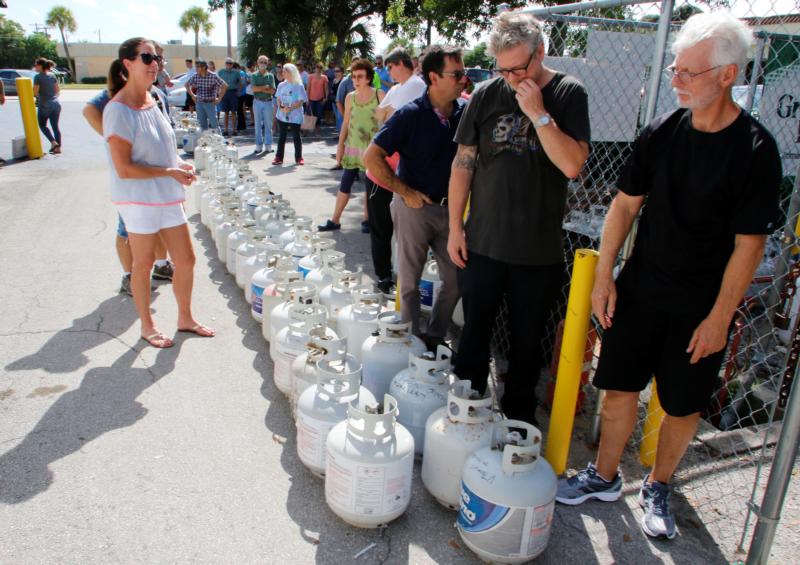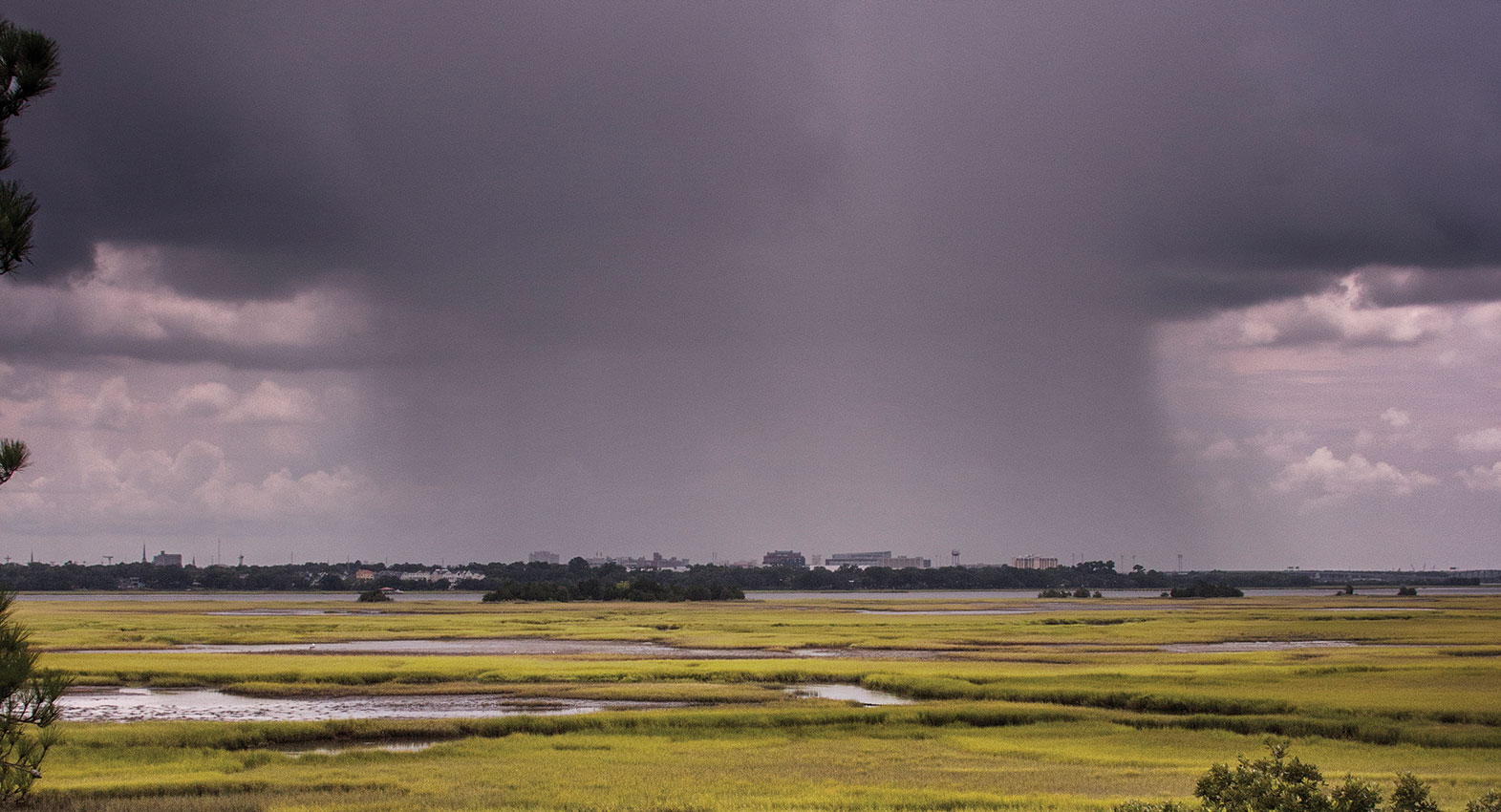
As dangerous and deadly Hurricane Irma makes landfall in Florida on Sunday, workers with Catholic Charities are planning their response if the storm hits anywhere in South Carolina.
Catholic Charities staff members held a planning meeting on Thursday, Sept. 7, to coordinate their response.
“We’re just going to be monitoring the situation over the weekend, and preparing to respond to whatever scenario unfolds,” said Kelly Kaminski, regional

coordinator for Catholic Charities in the Pee Dee and director of disaster services for the agency.
If the agency is called upon to help after Irma, it would be the third year in a row it has played a major part in assisting storm victims. They helped people in the Midlands and Pee Dee region who were affected by the massive floods of 2015, and are still aiding many whose homes were destroyed or damaged by Hurricane Matthew last year.
Irma’s track has turned farther to the west since Friday, taking some of the anticipated danger away from South Carolina, but because of the storm’s size, many counties in the state can still expect to see high winds, coastal flooding and a risk of tornadoes beginning Monday, officials said.
Gov. Henry McMaster ordered an evacuation of residents from barrier islands in Colleton, Jasper and Beaufort counties because of storm surges that could be as high as six feet. The evacuation order includes Ediston Beach in Colleton County; Hilton Head Island, Harbour Island, Hunting Island, Dafuskie and Fripp Islands in Beaufort County; and Knowles and Tullifini Islands in Jasper County.
As of Sunday afternoon, McMaster said the evacuations have gone well. By the end of the day Sunday, 22 shelters will be available to assist both state residents and evacuees from Florida and elsewhere who might need a placd to stay. Many of the shelters will be Williamsburg and Clarendon counties.
Storm surges from Irma will be felt along the coast from 10 a.m. to 4 p.m. Monday from Charleston County south. Coastal flooding could also affect counties on the northern coast.
Emergency officials are reminding state residents from the coast to the Midlands that Irma is hundreds of miles wide. Wind, rain and possible flooding from the storm could be felt well inland.
Because of the storm’s potential wide reach through the state, Kaminski said all Catholic Charities employees have been activated for disaster response work anywhere in the state.
Diocesan offices were shut down late Thursday afternoon in advance of the storm and will be closed until further notice.
While state and diocesan officials work to coordinate their own responses to Irma, there are important things everyone should do if they are in areas that could possibly be affected by a hurricane. Irma is the first major storm to threaten South Carolina in what is expected to be an unusually busy storm season. Hurricane season begins June 1 and runs through Nov. 30.
Earlier in the month, Kaminski prepared a list of storm preparation tips. Here is a look at the information she put together as well as some other suggestions to get ready for hurricanes.
Know where you are in relation to the highest threat area. “Your plan is going to need to be different if you live along a barrier island, which is under the highest threat from a hurricane, than it would be if you lived inland,” Walsh said. Understand the height of your neighborhood related to possible storm surge, because this surge of water is the biggest killer during a storm.
Know which zone you live in. Along the coast, residents live in designated zones according to their proximity to the shoreline. Know your zone so you quickly will be able to know if you should leave if the Governor calls for an evacuation.
Have a family plan. Know the evacuation routes your family will use if you leave ahead of a storm and know where you can go once you leave the area. Learn hurricane shelter locations if that is your planned destination, or know where else you can stay, whether at a friend or relative’s house or a hotel. Have contact numbers readily available and a meet-up place planned if the family is separated.
Gather necessary storm supplies. Whether you evacuate, go to a shelter or stay in your home, have on hand necessary medical supplies and other storm essentials including: emergency food and water for at least three days, flashlight and extra batteries, portable battery-operated radio and extra batteries, first aid kit and manual, non-electric can opener, cash and credit cards, sturdy shoes, changes of clothing and toys and games to keep children entertained. Have copies of important papers as well. In your home, store these supplies in a waterproof container.
Protect your home. Cover windows with permanent shutters, plywood panels or other shielding materials. Bring inside lawn furniture and other loose objects such as grills, garbage cans. If you have a mobile home, inspect and secure tie-downs.
Water. This is typically one of the first items to vanish from stores. If you can’t find any, create your own supply. You can fill pitchers, empty milk jugs or soda bottles, and even gallon-size freezer bags. Also, scour your tubs and fill them as a source of water for pets and for cleaning.
Remember to include your pets. Know your rights. Congress passed the Pets Evacuation and Transportation Standards Act after Hurricane Katrina, which means people under evacuation orders cannot be turned away from shelters because of pets. Mention this law to hotels when making reservations to ensure they are pet-friendly. Prepare a pet-survival kit to take with you, which includes a carrier, proper ID and collar, medications, proof of vaccination and rabies tags for dogs or cats, at least a 14-day supply of dry food, water and food bowls and other supplies your animals will need.
Some websites with information about hurricane prep:
- The South Carolina Emergency Management Division’s latest hurricane guide: http://www.scemd.org/planandprepare/preparedness/preparefor/26-guides-and-brochures/142-south-carolina-hurricane-guide
- Printed copies of the guide are also available at Department of Motor Vehicles offices in coastal counties, at South Carolina welcome centers, and at Walgreens’ stores.
- American Red Cross publishes a concise hurricane prep checklist.
- More detailed guides are available at the Red Cross website.
- FEMA even offers a free app that gives weather alerts from the National Weather Service for up to five locations across the country. It also locates open shelters, offers safety tips, an area for disaster reporting, maps, and a section on how to apply for assistance. It is available in Spanish and English. It is free in the App Store for Apple devices and Google Play for Android devices.
Hurricane prayer
O Heavenly Father, all the elements of nature obey Your commands, including hurricanes. Calm the storms that threaten us and turn our fear of Your power into praise of Your goodness. Grant this through Our Lord Jesus Christ, Your Son, Who lives and reigns with the Holy Spirit, one God, forever and ever. Amen.



